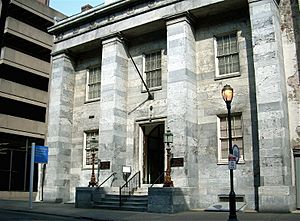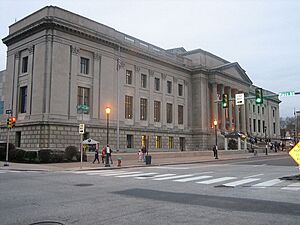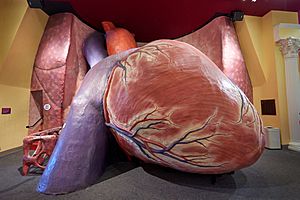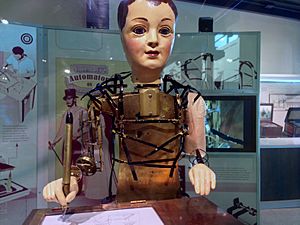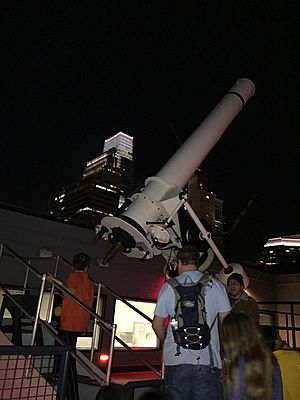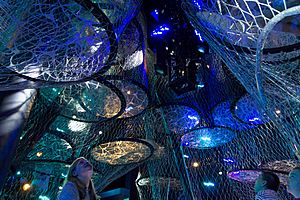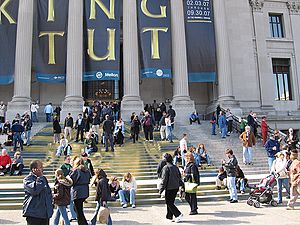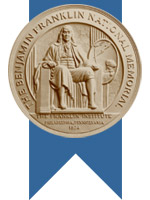Franklin Institute facts for kids
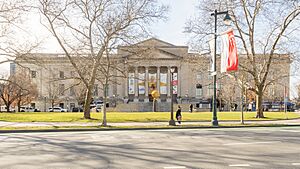
The Franklin Institute in March 2024
|
|
| Established | 1824 |
|---|---|
| Location | 222 North 20th Street, Philadelphia, Pennsylvania, U.S. |
| Type | Science museum |
| Public transit access | |
|
The Franklin Institute Science Museum
|
|
| Area | 4.4 acres (1.8 ha) |
| Built | 1931 |
| Architect | Windrim, John Torrey; Day & Zimmermann |
| Architectural style | Classical Revival |
| NRHP reference No. | 85000039 |
| Added to NRHP | January 3, 1985 |
The Franklin Institute is a fun science museum and a place for learning about science in Philadelphia, Pennsylvania. It is named after Benjamin Franklin, a famous American scientist and leader. The museum is also home to the Benjamin Franklin National Memorial.
The Franklin Institute started in 1824. This makes it one of the oldest places in the United States dedicated to science education and discovery. Its main astronomer, who studies stars and planets, is Derrick Pitts.
Contents
Exploring the History of the Franklin Institute
How the Institute Began
On February 5, 1824, two people named Samuel Vaughan Merrick and William H. Keating started the Franklin Institute. They wanted to help develop new ideas and skills in mechanical arts.
The institute quickly became important for science and technology in the 1800s. It studied things like steam engines and water power. Besides doing scientific research, it also helped people learn. It ran schools, published a well-known magazine called Journal of The Franklin Institute, held exhibitions, and gave awards for new inventions.
The 20th Century: A Focus on Public Learning
Later in the 1900s, the Franklin Institute changed its main focus. It became more about teaching science to everyone through its museum. Some of its research groups, like the Bartol Research Foundation, moved to other universities.
Many scientists showed off amazing new technology at the Franklin Institute. In 1884, it hosted the first big electrical show in the United States. Later, in 1934, Philo Taylor Farnsworth showed the world's first all-electronic television system there.
The institute also made history by being inclusive. Elizabeth Skinner became the first female member in 1833. In 1870, Octavius Catto, a teacher and activist from Philadelphia, became a member, making the institute racially integrated.
The original building became too small. So, in 1934, the institute moved to its current home on the Benjamin Franklin Parkway. The new building was designed for hands-on learning. Visitors were encouraged to touch and use exhibits to understand how things work.
In 1940, a funny (but scary at the time) prank happened. A press agent joked that the world would end the next day. A radio station reported it, causing a panic. The Franklin Institute quickly told everyone it was just an April Fool's joke.
The 21st Century: New Challenges and Achievements
In 2017, something unfortunate happened during a party. A visitor broke off a thumb from a valuable Terracotta Army statue on loan from China. This caused a lot of anger in China. The Franklin Institute worked to improve its security to prevent similar incidents.
In 2021, the institute hosted Dyymond Whipper-Young. She broke a Guinness world record for creating the "world's largest drawing by an individual."
Supporting Science Education
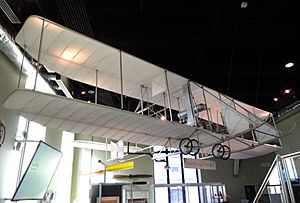
In 2006, the Franklin Institute started a big fundraising effort called "Inspire Science!" This campaign aimed to build new parts of the museum and create new exhibits.
In 2011, the institute received a huge gift of $10 million from Athena and Nicholas Karabots. This was the largest gift in its history. This money helped build the Nicholas and Athena Karabots Pavilion. This new area includes a large exhibit about the brain (neuroscience), a conference center, and classrooms.
Exploring the Science Center
The most famous part of the Franklin Institute is its Science Museum. Its goal is to help people understand and love science and technology. The museum has the largest collection of items from the Wright brothers' workshop.
Cool Permanent Exhibits
- Electricity: This exhibit shows how electricity works and how we use it today. You can see a dance floor that creates electricity and lights that turn on from cell phone signals.
- Changing Earth: Learn about the powerful forces of air, water, and land that shape our planet. See how humans interact with these forces.
- The Franklin Airshow: This area features the Wright Model B airplane and a United States Air Force T-33 jet trainer. It's all about aviation and technology.
- The Giant Heart: This huge, walk-through heart has been a symbol of Philadelphia since 1954. It teaches you about biology and how your body works.
- Joel N. Bloom Observatory: Look through powerful telescopes, including a large 10-inch Zeiss Refractor, to see stars and planets at night.
- SportsZone: Discover the science behind your favorite sports in this interactive exhibit.
- The Train Factory: See a real Baldwin 60000 steam locomotive! This exhibit is currently being updated and will reopen in the fall of 2024.
- Sir Isaac's Loft: Combine art and science to create your own masterpiece.
- Space Command: See real space suits and track satellites in real time.
- Amazing Machine: Explore a machine-like environment with unique items from the Franklin Institute's collection, including Maillardet's automaton.
- Your Brain: Learn about your amazing brain! This exhibit has an 18-foot-tall climbing structure that looks like brain pathways. It also has many interactive activities.
Other Cool Things to See
Outside the museum, you can see the Budd BB-1 Pioneer flying boat. This was the world's first stainless steel airplane. It has been on display since 1935.
You can also see a model of what would become the Lunar Module from the Apollo space program. This model was first shown at the 1966–67 World's Fair.
Theaters at the Institute
In 1933, the Fels Planetarium was built. It was only the second planetarium in the United States. It was rebuilt in 2002 with a new, lighter dome that is 60 feet wide.
The Tuttleman IMAX Theater was a huge dome theater. It closed in 2020 and the museum decided in November 2023 that it would stay closed permanently. The museum is now focusing on new exhibits instead.
The museum's main auditorium was updated and renamed Franklin Theater. It shows educational films and even some popular movies.
Traveling Exhibits
The Science Center often hosts special traveling exhibits. In the past, these have included shows about the Titanic, Body Worlds, and Robots. In 2007, the Franklin Institute hosted Tutankhamun and The Golden Age of The Pharaohs. This exhibit was much larger than the original King Tut show from the 1970s. It featured many items from King Tut's tomb and other ancient Egyptian tombs.
The Franklin Institute is part of a group of science museums that work together to share exhibits and ideas.
Benjamin Franklin National Memorial
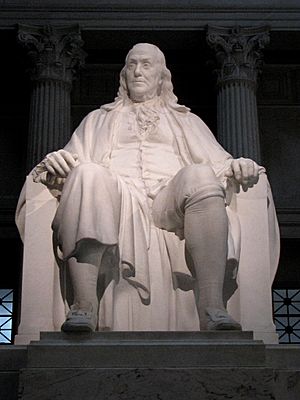
The Benjamin Franklin National Memorial is inside the Franklin Institute. It features a huge 20-foot-tall marble statue of Benjamin Franklin. The memorial opened in 1938 and looks like the Pantheon in Rome. The main hall is 82 feet long, wide, and high. Its domed ceiling is self-supporting and weighs 1600 tons! The walls and floors are made of beautiful marbles from different countries.
In 1972, the United States Congress officially named the hall and statue the Benjamin Franklin National Memorial. In 2008, the memorial was updated with new multimedia features. Now, you can watch a 3.5-minute show called Benjamin Franklin Forever that uses the entire rotunda to tell his story.
The institute also has a special collection of items related to Benjamin Franklin. These include his 1777 Nini Medallion, a small model of the statue, his ceremonial sword, and the odometer he used to measure postal routes. The Electricity exhibit also shows one of Franklin's lightning rods and his electricity tube.
The Journal of The Franklin Institute
In 1826, The Journal of The Franklin Institute was created. It published information about US Patents and new scientific discoveries. It is one of the oldest science magazines in the country that has been published continuously. Today, it mainly focuses on engineering and applied mathematics.
Awards for Science and Innovation
Since 1824, the Franklin Institute has given out science and technology awards. This is one of the oldest award programs in the world! Famous past winners include Henry Ford, Marie Curie, and Thomas Edison.
Since 1998, many of the older awards were combined into the Benjamin Franklin Medal. Several of these medals are given out each year for different areas of science and engineering. These areas include "Chemistry", "Computer and Cognitive Science", "Earth and Environmental Science", "Electrical Engineering", "Life Science", "Mechanical Engineering" and "Physics".
The institute also gives out the Bower Award and Prize for Achievement in Science. This award includes $250,000, which is one of the largest cash prizes for a science award in the U.S.
Learning and Research at the Institute
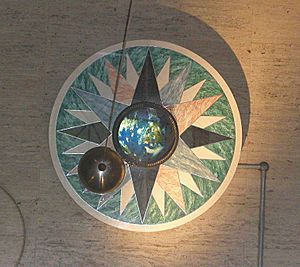
The Franklin Institute also studies how people learn science outside of school. They focus on using technology for education, working with schools, and helping young people become leaders. They also have many online resources about the history of science.
Special Programs for Students and Teachers
Science Leadership Academy
The Science Leadership Academy is a special school that started in 2006. It is a partnership between the Franklin Institute and the School District of Philadelphia.
Teacher Training
The Franklin Institute offers special summer programs and shorter courses for teachers. These programs help teachers learn new ways to teach science to younger students.
Partnerships for Achieving Careers in Technology and Science (PACTS)
PACTS is a year-round program for middle and high school students. It helps them explore science, develop career skills, and become leaders. Students do hands-on science activities, field research, and lab experiments.
Girls at the Center
Girls at the Center was a program that helped girls and their families learn about science together. It was a partnership between the Franklin Institute and the Girl Scouts of the USA. Many groups participated, and it helped girls do science projects at home and at the museum.
See also
 In Spanish: Franklin Institute para niños
In Spanish: Franklin Institute para niños
- Academy of Natural Sciences
- Children's museum
- List of science museums
- Logan Square
- National Treasure, a 2004 film that features the museum
- Wagner Free Institute of Science


